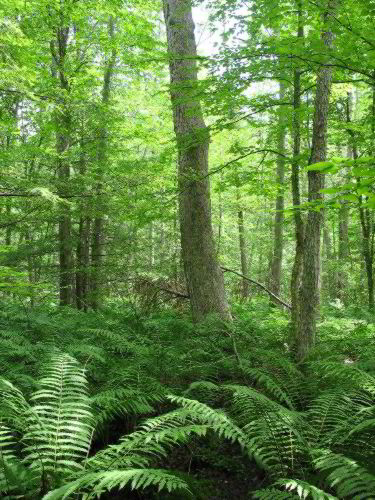|
==============================================================================
TOPIC: Cicero Swamp Wildlife Management Area
http://groups.google.com/group/entstrees/browse_thread/thread/af8677deca7cce65?hl=en
==============================================================================
== 1 of 1 ==
Date: Sat, Jul 5 2008 9:21 am
From: "Jess Riddle"
Ents,
Across much of central New York, forests still cover a substantial
proportion of the landscape, but agriculture and other development
have left them highly fragmented. They remain as strips on the
steep
slopes bordering broad valleys, narrow ribbons along streams, and in
blocks wedged between fields. However, just eight miles
northeast of
Syracuse, mature forests occupy almost all of Cicero Swamp Wildlife
Management Area's 5000 acres. The forest rises out of a layer
of peat
over four feet thick that limits the influence of underlying marl
and
glacial till (LeBlanc and Leopold 1992).

Forest fragments in central New York
Those saturated soils allow red maple to dominate the overstory and
ferns to dominate the groundcover. In the wetter parts of the
swamp
where the red maple canopy can not close, green ash, speckled alder,
black ash and small American elms grow interspersed.
Underneath,
dense stands of cinnamon fern and thickets of common winterberry
arch
off of somewhat elevated hummocks, and netted chain fern occupies
broader wet areas.

Cinnamon fern and sphagnum
In slightly less wet parts of the swamp, red maple
forms a dense canopy shared with only black gum and scattered yellow
birch. Black gum's undesirable wood led loggers to bypass the
species
when clearing the rest of the swamp, so groves of ancient
individuals
still flourish. Below the maples and black gums, a continuous
layer
of cinnamon fern hides the hollows, hummocks, and sphagnum that
occur
on the ground surface.

Black gum amongst cinnamon ferns
Goldthread, wild sarsaparillas, and star
flower grow abundantly on slightly raised areas where the cinnamon
fern is not too thick. Where the land rises above the water
table,
red maple still dominates, but red oak and shagbark hickory can also
compete. On some of those sites, a dense hemlock midstory
precludes
much herbaceous growth, but where more light reaches the forest
floor,
ferns, sedges, and poison ivy are abundant. Spicebush also
flourishes
in those areas and sometimes extends out onto hummocks in wetter
areas. On the highest ground, where rare ridges extend out
into the
swamp and rise about 10' above the surrounding landscape, a more
typical northern hardwood forest develops. Beech, sugar maple,
and
yellow birch form the canopy with interspersed black cherry,
hemlock,
basswood, and shagbark hickory. Witch-hazel and ironwood
dominate the
understory, and flowering herbs largely displace the ferns in the
ground layer. Transitional areas between the ridge and
adjacent
flooded areas support a wide variety of species including bur oak,
silver maple, bitternut hickory, and American elm. I plan to
visit a
boggy section of the swamp with a disjunct populations of black
spruce
and eastern larch and a shrub layer of mountain holly (Ilex
mucronata), highbush blueberry, and black chokeberry.

Old black gum
Tree sizes in the swamp are generally not exceptional with most
closed
canopy areas under 100' in height. The largest circumference
trees
are a few black gum and red maples that exceed nine feet cbh.
The
largest black ash tend to grow on slightly better drained sites than
where the species is most abundant, and the quaking aspen grow in
old
field stands.
Alder, Speckled 10.5" 28.9'
Ash, Black 3'5" 73.5'
Ash, Black 4'0" 91.1'
Aspen, Quaking 4'8" 80.6'
Aspen, Quaking 4'9.5" 85.5'
Serviceberry, Downy 3'5"
I'll send some photos to Ed.
Jess Riddle
LeBlanc CM, Leopold DJ. 1992. Demography and age structure of a
central New York shrub-carr 94 years after fire. Bulletin of the
Torrey Botanical Club 119(1): 50-64
==============================================================================
TOPIC: Cicero Swamp Wildlife Management Area
http://groups.google.com/group/entstrees/browse_thread/thread/af8677deca7cce65?hl=en
==============================================================================
== 1 of 3 ==
Date: Sun, Jul 6 2008 6:21 am
From: Will Fell
Jess;
Fantastic account!!!
I have always enjoyed your trip descriptions as you so completely
cover the history, soils/geology and geography of the locations
along
with the plant/tree associations and their interaction. It was
fascinating to me to read your accounts of the upstate Carolinas
along
with N. Georgia as these were areas I had visited or similar areas
yet
I never was that familiar or understood the relationships between
all
these associations. Now I am reading about upstate NY and you paint
a
picture I can visualize having never set foot in a northern swamp
like
that. Keep up the good work. You need to write a book on all these
areas you have visited. I have read Wharton's Natural Env. of GA and
Weakley's Classification of NC Natural Commumities and you are
easily
within their league if not more complete. I anxiously await its
publication......
Thanks.....Will Fell
== 2 of 3 ==
Date: Sun, Jul 6 2008 8:52 am
From: Gary Smith
Jess,
Nice report.
I have no experience with northern swamps either, but I'm surprised
at
no mention of Atlantic white cedar. From my readings, the peaty
areas
you describe sound like a pretty good spot for them to hang out.
gs
== 3 of 3 ==
Date: Sun, Jul 6 2008 7:15 pm
From: James Parton
Jess,
I bet the Cinnamon Fern carpeting the forest floor is very
beautiful!
James P.
==============================================================================
TOPIC: Cicero Swamp Wildlife Management Area
http://groups.google.com/group/entstrees/browse_thread/thread/af8677deca7cce65?hl=en
==============================================================================
== 1 of 1 ==
Date: Wed, Jul 9 2008 9:06 pm
From: "Dale Luthringer"
Jess,
We ought to have a tough time beating, 28.9' for speckled alder down
here. Most I see rarely break 15'.
Dale
|